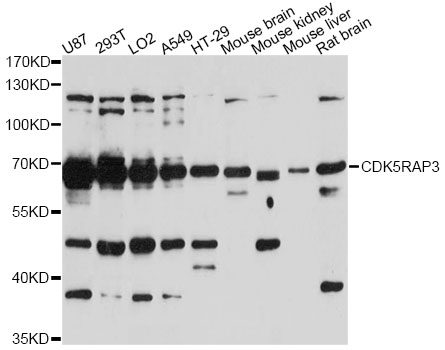-
Product Name
CDK5RAP3 Polyclonal Antibody
- Documents
-
Description
Polyclonal antibody to CDK5RAP3
-
Tested applications
WB, IHC, IF
-
Species reactivity
Human, Mouse, Rat
-
Alternative names
CDK5RAP3 antibody; C53 antibody; HSF-27 antibody; IC53 antibody; LZAP antibody; MST016 antibody; OK/SW-cl.114 antibody; PP1553 antibody; CDK5 regulatory subunit-associated protein 3 antibody
-
Isotype
Rabbit IgG
-
Preparation
Antigen: Recombinant fusion protein containing a sequence corresponding to amino acids 1-300 of human CDK5RAP3 (NP_788276.1).
-
Clonality
Polyclonal
-
Formulation
PBS with 0.02% sodium azide, 50% glycerol, pH7.3.
-
Storage instructions
Store at -20℃. Avoid freeze / thaw cycles.
-
Applications
WB 1:500 - 1:2000
IHC 1:50 - 1:100
IF 1:50 - 1:100 -
Validations

Western blot - CDK5RAP3 Polyclonal Antibody
Western blot analysis of extracts of various cell lines, using CDK5RAP3 antibody at 1:3000 dilution.Secondary antibody: HRP Goat Anti-Rabbit IgG (H+L) at 1:10000 dilution.Lysates/proteins: 25ug per lane.Blocking buffer: 3% nonfat dry milk in TBST.Detection: ECL Enhanced Kit .Exposure time: 90s.
-
Background
Probable tumor suppressor initially identified as a CDK5R1 interactor controlling cell proliferation. Negatively regulates NF-kappa-B-mediated gene transcription through the control of RELA phosphorylation. Also regulates mitotic G2/M transition checkpoint and mitotic G2 DNA damage checkpoint. Through its interaction with CDKN2A/ARF and MDM2 may induce MDM2-dependent p53/TP53 ubiquitination, stabilization and activation in the nucleus, thereby promoting G1 cell cycle arrest and inhibition of cell proliferation. May play a role in the unfolded protein response, mediating the ufmylation of multiple proteins in response to endoplasmic reticulum stress. May also play a role in the rupture of the nuclear envelope during apoptosis. May regulate MAPK14 activity by regulating its dephosphorylation by PPM1D/WIP1.; (Microbial infection) May be negatively regulated by hepatitis B virus large envelope protein mutant pre-s2 to promote mitotic entry.
Related Products / Services
Please note: All products are "FOR RESEARCH USE ONLY AND ARE NOT INTENDED FOR DIAGNOSTIC OR THERAPEUTIC USE"
